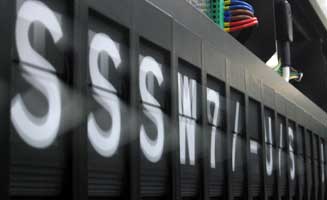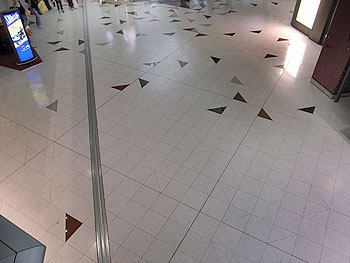Powers of Ten is a 1977 short documentary film written and directed by Charles Eames and his wife, Ray. The film depicts the relative scale of the Universe in factors of ten.
The picnic location on Google Maps.
Powers of Ten is a 1977 short documentary film written and directed by Charles Eames and his wife, Ray. The film depicts the relative scale of the Universe in factors of ten.
The picnic location on Google Maps.

DISLOCATE July 24th – August 5th 2007
Ginza Art Laboratory, Toyko, Japan.
Dislocate is a project which examines the relationship between art, technology and locality. Designed to facilitate international dialogue between artists, researchers and the public, Dislocate encourages exchange and reflection upon our experiences and perceptions of the interplay between these elements. This year the events will focus on our ability to reconnect with our location, seeking to explore, question and debate how can technology be used to heighten our engagement with our surroundings instead of isolating us from our immediate space.
Dislocate aims to explore the potential new media has to increase our awareness of our environment, enhance participation in our locality and community and transform our perceptions of the space we inhabit. Does new media enable us to plug into our locality, or is disconnection inevitable? As mobile and wireless technologies increasingly enable us to transcend space, our electrical roots are dug up, but are the roots which bind us with a place also cut? Dislocate will call into question the necessity of an intermediary to our immediate surroundings, asking if mediation is a means of connecting or distancing, an expansion or an obstruction? Dislocate offers the space to investigate the creative and social potential of new media to engage us with our direct locality and to ask what is the importance of where we are now?
Held over two sites, of contrasting locality, Dislocate will present new possibilities of our immediate space and the multiple connections which link to elsewhere. There will be a particular relationship to the surrounding site of the exhibition venues encouraging interaction and engagement with this environment while also fusing with spaces beyond.
The exhibition includes Martin John Callanan’s recent work Location of I, and Slade alumni Naoko Takahashi.
![]()
Outlook Express(ed)
Oakville Galleries in Gairloch Gardens, Oakville, Ontario, Canada
Lois Andison, Susan Collins and David Rokeby
Curated by Marnie Fleming
29 June to 26 August 2007 in Gairloch Gardens
Outlook Express(ed) looks at how new media has offered artists Lois Andison, Susan Collins and David Rokeby innovative ways of thinking about time, and thus the ability to create new ways of representing landscape.
Each has examined a precise geography, from a specific outlook, revealing the fleeting qualities of the landscape and its constantly shifting tableaux. Their work demonstrates the passage of time as the seasons pass and as the earth hurtles along in its perpetual orbit.
Andison, Collins and Rokeby deal with the transformative process of real time in a particular
landscape using new media technology. Therefore, the title Outlook Express(ed), “expresses”
a playful double entendre – referring to a specific place, while also referencing a popular,
technological, timesaving computer programme. While quite diverse in their chosen outlooks,
the artists share common constructs that are both digitally and data-driven. Over an extended
period, they have recorded and accumulated images to form an archive of their specific landscapes,
or perhaps, more correctly, “data-scapes.”
It is in the amassing of their information that surprising encounters become revealed, as a result
either of human interaction or of natural forces. And while the underlying landscapes largely
remain constant, many mini-events unfold. For example, in Andison’s time and again, a
neighbour’s garage, seen from the artist’s bedroom window, is torn down and eventually replaced
by a new construction. Collins’s carefully programmed Glenlandia reveals the subtle effects upon
a Scottish vista in which a loch’s water levels rise and fall and the moonlight waxes and wanes.
Rokeby’s Machine for Taking Time, situated in Gairloch Gardens, attests to the seasonal plantings
of the garden, particular behaviors of Canadian geese, and an array of other events that occur
beyond the limits of our normal perception.
From the outset the artists have manipulated the time and space of the landscape in the act of
recording it by digital camera or Webcam, and then again, in the final screening of the image.
The completed work is no longer confined within the same temporal and spatial boundaries,
but rather is turned into riffs and ruminations, sampled and shuffled through digital processes.
Their images are not static but traverse from one time-frame to the next, thereby negotiating new
positions with the present. The “outlooks” slip in and out of linear time, resulting in landscapes
that are re-shaped and transformed. They allow us to perceive new incidental details that our eyes
and memory initially failed to record. We are made to see the landscape in a way that was not
previously understood.
Exhibition opening: Thursday 28 June , 7 to 10 pm.
Oakville Galleries in Gairloch Gardens is located at 1306 Lakeshore Road East, 2 km east of downtown Oakville.
The gallery is open 1 to 5 pm Tuesday to Sunday.
Admission is free.
For further information on Oakville Galleries,
please call 905.844.4402 or visit http://www.oakvillegalleries.com

The latest edition of the Toronto based digital arts quarterly vagueterrain.net is now live. The issue, vague terrain 07: sample culture is a provocative exploration of contemporary sampling of sound, image and information. This body of work examines the remix as a critical practice while addressing broader issues of ownership and intellectual property.
Vague terrain 07: sample culture contains work from: brad collard, christian marc schmidt, defasten, des cailloux et du carbone, [dNASAb], eduardo navas, eskaei, freida abtan, jakob thiesen, jennifer a. machiorlatti, noah pred, ortiz, rebekah farrugia, and an interview with ezekiel honig conducted by evan saskin.

If you are in London head down to the BFI on Southbank to see the installed version of BEACON; Thomson&Craighead’s latest work.
 Here’s a digest of what we’re up to over the summer -well in June and July at any rate. We hope some of you can make some of it.
Here’s a digest of what we’re up to over the summer -well in June and July at any rate. We hope some of you can make some of it.
The image you can see on the left is the new railway flap sign we have built to display our work BEACON. It’s a development shot taken in the factory at Solari of Udine in Italy when we visited during April.
You can find out more about BEACON and our other recent work by visiting our website
You can view an online version of BEACON by clicking here
___ 1. BEACON / BFI SOUTHBANK
After two years in the making, we are finally launching the mechanical version of BEACON as a railway flap sign at BFI, Southbank from 23rd June – 12th August 2007. There’s an opening from 7pm – 9pm on Friday 22nd June. After London the sign travels to FACT in Liverpool and then Artists Space in New York. The sign has been built by Solari of Udine in Italy.
___ 2. ACCUMULATED OUTLOOK / OAKVILLE GALLERIES
The gallery version of Decorative Newsfeeds is part of Accumulated Outlook at Oakville Galleries in Canada from 29th June – 26th August 2007. It will be at their Centennial Square site with a launch party on Thursday 28 June 2007. We are also almost finished making a new outdoor version of Decorative Newsfeeds for The Junction in Cambridge.
___ 3. THE LOST O / ASHFORD
A new version of our generative music system called Diminished 7th is part of The Lost O in Ashford, Kent on 7th and 8th July, which coincides with Tour de France passing through the town on this year’s UK first stage. Diminished 7th was first developed for Arts Transpennine 2003 and used cows rather than sheep as is the case here with version 1.1
___ 4. THE CENTRE OF ATTENTION MAG NO.4
The Centre of Attention Magazine no.4 is on DVD and includes one of our template cinema works. The magazine launches on Sunday 29th July 2007 at the Publish and Be Damned Fair, Rochelle School, London E2 7ES.
___ 5. LAST CHANCE TO SEE
FEEDBACK in the new Laboral Gallery in Gijon and My own Private Reality at Edith Russ Site in Oldenburg.
Friday 13 July 2007, 10.00–18.30
This international symposium brings together some of the world’s leading media artists, theorists and researchers to explore real-time interaction in electronic media. Over the last few years network theories have started to shape our thinking about social and cultural issues. This event seeks out artistic strategies and art forms that engage with these ideas. Contributors include: Mark Amerika, Alexander R Galloway, Andrea Zapp, Kelli Dipple, Kate Rich, Paul Sermon and Kate Southworth.
This event will be webcast

Friday 22th June 8pm & Saturday 23rd June 4pm
A two-part event of video screenings, 16mm film projection and performance brings together internationally recognised film-makers with artists from Stroud and the South West. Performance is central to much of the work: walking backwards as a way of remembering; re-enacting the painting of a wall onto the projected image; playing the piano as an act of remembrance. Many of the films use song or music: a film with live accompaniment on the saxophone; poetry set to song as the starting point for a sequence of short films. From digital archive to recollections recorded on film, this event explores ideas of memory and its association with place. Includes work by Slade academic staff: Susan Collins, Phil Coy, Jayne Parker, Sean Borodale & Louisa Fairclough More details

In an attempt to become the absolute citizen, Martin John Callanan will continually and openly publish his physical location live.
“I am contactable, and I am findable, in the digital world. It is easy to find me, write to me, work with me, and speak to me. However, people have trouble meeting the physical me, in the physical world. I have become so findable and so contactable: I hide. Perhaps not purposely, more though the perception I do not need to be physically present, because I feel present already.”
“By becoming findable – to anyone, anywhere – in the physical world, I can participate fully and with anyone: I become the absolute citizen.”
“I become a citizen of both the physical and digital worlds, coexisting as one (the same device that makes me visible and findable, allows continuous instant connection – communication – via any digital means); I cannot hide (and I become vulnerable).”

SCEMFA is pleased to welcome Grahame Weinbren as artist-in-residence for Autumn 2007. A pioneer in interactive cinema his installations have been exhibited widely internationally including the Whitney Museum of American Art, LAMOCA, the Guggenheim Museum, the Berlin Film Festival, and the Centre Georges Pompidou with commissions including the National Gallery of Art, the City of Dortmund, and the InterCommunications Center of Tokyo. Weinbren has published and lectured internationally on cinema, interactivity, and new technology, and is editor of the Millennium Film Journal.